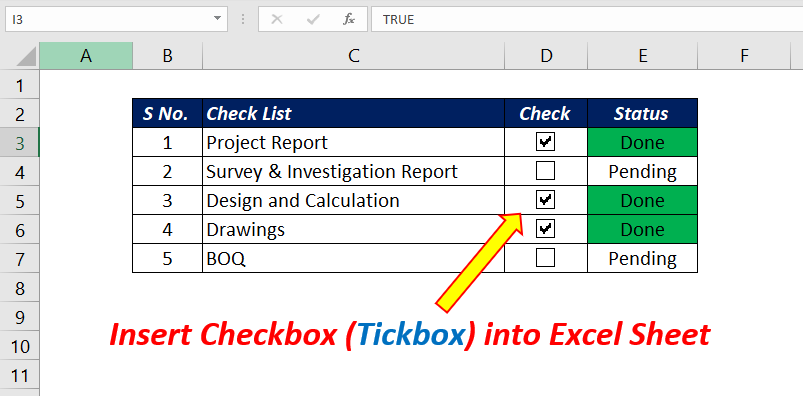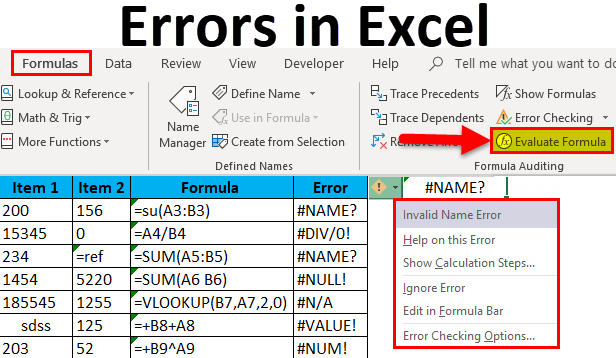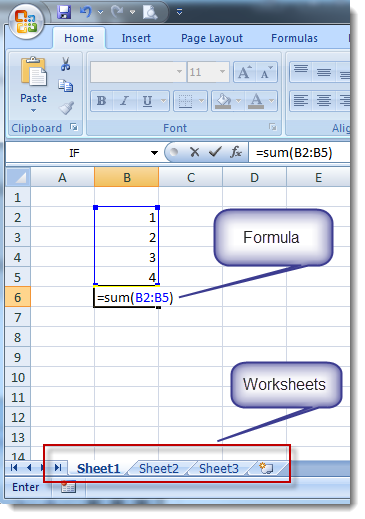In Microsoft Excel, a column runs vertically in the grid layout of a worksheet. Vertical columns are numbered with alphabetic values such as A, B, C. Here is a list of topics that explain how to use columns in Excel. Ms word is a word processing software which is used for typing, writing letters, making documents etc. On the other hand MS Excel is a spreadsheet software which is used creating document in a tabular form, especially documents which require calculation and presentation of data in short and precise manner. Microsoft Excel isn't available as a standalone program, but it is included in a Microsoft Office package or subscription. 2 Open an existing Excel document. If you want to open an existing Excel document at any time, simply double-click the document in question. Microsoft Excel is a spreadsheet developed by Microsoft for Windows, macOS, Android and iOS. It features calculation, graphing tools, pivot tables, and a macro programming language called Visual Basic for Applications (VBA).
Excel. Chances are, that word alone inspires visions of lengthy spreadsheets, complicated macros, and the occasional pivot table or bar graph.
It’s true—with more than one billion Microsoft Office users globally, Excel has become the professional standard in offices across the globe for pretty much anything that requires management of large amounts of data.
But, if you think Excel is only good for making you cross-eyed while looking at a bunch of numbers and financial reports, think again. As Tomasz Tunguz points out, there are tons of uses of Excel in business (and beyond) outside of simple spreadsheets. In fact, the potential uses are seemingly endless.
There’s no way for us to compile a list that captures every one of Excel’s possible applications (even if you were up for reading a War and Peace-sized listicle).
However, in an effort to demonstrate the power and flexibility of everybody’s favorite spreadsheet tool, we’ve pulled together different ways that you could use Excel—both professionally, personally, and just for the fun of it.
Free Excel crash course
Learn Excel essentials fast with this FREE course. Get your certificate today!
Start free courseAll about numbers
Of course, the core purpose of Excel all boils down to numbers. If you need to sort, retrieve, and analyze a large (or even small!) amount of data, Excel makes it a breeze.
Here are a few broad categories to keep in mind when it comes to implementing Excel for anything numbers-related.
1. Calculating
Find yourself running the same calculations over and over again? Build yourself a totally customized calculator in Excel by programming your commonly-used formulas. That way, you just need to punch in your digits and Excel will spit the answer out for you—no elbow grease required.
2. Accounting
Budget plans, forecasts, expense tracking, financial reports, loan calculators, and more. Excel was pretty much designed to meet these different accounting needs. And, considering that 89 percent of companies utilize Excel for its various accounting functions, it obviously fits the bill.
Excel even has numerous different spreadsheet templates to make all of those processes that much easier.
3. Charting
Pie charts, scatter charts, line charts, bar charts, area charts, column charts—the list goes on and on. If you need to find a way to represent data in a more visual and digestible way, Excel’s ability to transform rows and columns of digits into beautiful charts is sure to become one of your favorite things about it.
Want more information about the types of charts you can create in Excel? This article is a helpful resource.
Want to learn more?
Take your Excel skills to the next level with our comprehensive (and free) ebook!
4. Inventory tracking
Tracking inventory can be a headache. Fortunately, Excel can help to keep employees, business owners, or even individuals organized and on top of their inventory—before any major problems crop up.
Making a plan
Let’s move on from the numbers—there are plenty of things that Excel can help you plan and organize that don’t necessarily involve endless rows of digits.
5. Calendars and schedules
Need to map out a content calendar for your blog or website? Lesson plans for your classroom? A PTO schedule for you and all of your co-workers? A daily schedule for you or your family? When it comes to various calendars, Excel can be surprisingly robust.
6. Seating charts

From a large corporate luncheon to a wedding, arranging a seating chart can be a royal headache. Fortunately, Excel can make it a total breeze. If you’re a real whiz, you’ll be able to automatically create your seating chart using your spreadsheet of RSVPs. Need help getting this done? This article provides a detailed walkthrough of how you can create a seating chart in Excel.
7. Goal planning worksheet
From professional goals to fitness goals to financial goals, it helps to have something to keep you focused and on track. Enter the beauty of Excel. Using the tool, you can create various worksheets, logs, and planning documents to help you monitor your progress—and, hopefully, cross the finish line.
8. Mock-ups
Excel might not be the first platform you think of when it comes to design. But, believe it or not, you can use the tool to put together various mock-ups and prototypes. In fact, it’s a surprisingly popular choice for creating website wireframes and dashboards.
Getting stuff done
Want to kick your productivity into high gear? Well, Excel can swoop in and save the day with a variety of uses that can help you tackle your tasks and to-dos with ease and organization.
9. Task list
Say goodbye to your standard pen and paper to-do list. With Excel, you can make a far more robust task list—and even track your progress on those larger to-dos that are currently on your plate.
10. Checklist
Similarly, you can create a simple checklist that allows you to tick off the things you’ve purchased or accomplished—from a grocery list to a roster of to-dos for an upcoming marketing campaign.
11. Project management charts
We’ve already touched on the fact that Excel is a total beast when it comes to creating charts. And, this concept holds true when it comes to various charts for project management. Velvet rope album tracklist.
From waterfall charts to manage your team’s progress to kanban style boards (just like Trello!) to keep things organized, there are tons of ways that Excel can help keep your project on track.
12. Time logs
You know that tracking time can be a huge asset to you and your productivity. While there are plenty of fancy apps and tools to help meet that need, you can think of Excel as the original tool for logging your time. And, it still serves as a suitable option today.
Involving other people
Need to collect information from other people? Survey tools and forms are one option. But, rest assured, you can also create your own in Excel.
13. Forms
From simple to complicated, Excel is a great option for creating forms. You can even program various drop-down menus so that users can select their choice from a pre-set list.
14. Quizzes
Trying to test somebody else’s—or even your own—knowledge of a subject? In Excel, you can create a bank of questions and answers in one worksheet, and then instruct Excel to quiz you in another.
Staying in touch
Managing relationships is crucial to your success both professionally and personally. Fortunately, Excel makes it easy to keep in touch.
15. CRM
Need a lightweight CRM to stay top of mind for your customers? You can make one in Excel. And, the best part? Building your own means it will be totally customizable. Sales Hacker also put together a nifty set of free sales excel templates you can use to help get started!
16. Mailing list
Data doesn’t just have to involve numbers. Excel is also great at managing and sorting large amounts of names and addresses—making it the perfect solution for your invite list for that company holiday party or the mailing list for that large promotion or campaign.
Using Excel, you can also mail merge—which makes it that much easier to print address labels and other necessary materials.
You can also apply a similar concept to create things like directories, RSVP lists, and other rosters that involve a large amount of information about people.
Just for fun
Excel doesn’t need to be all work and no play. There are plenty of other fun things you can create using the spreadsheet tool.
17. Historical logs
Whether you want to keep track of the various craft beers you’ve tasted, the workouts you’ve completed, or something else entirely, you can think of Excel as your go-to resource for keeping those things sorted and logged.
18. Sudoku puzzles
Love Sudoku puzzles? As it turns out, you can make your own in Excel. Or, if you find yourself stuck on a particularly challenging one, you can enlist the help of Excel to help you get it figured out!
Need help creating the Sudoku solver and generator? This post will get you well on your way!
19. Word cloud
Word clouds might not be the most scientific representations of data. But, they’re a fun (not to mention beautiful way) to gain an understanding of what words are being utilized most. You guessed it—you can create one using Excel. Here’s how to use information from Excel to create a word cloud in Wordle.

20. Art and animations
The capabilities of Excel likely extend far beyond what you’d initially anticipate. In fact, many people have used the tool to create some downright awesome art—from pixelated portraits to animations.
21. Trip planner

Have a vacation coming up? Make sure you have everything covered by creating yourself a helpful itinerary before you pack your bags and head out. Excel even has a handy trip planner template you can use to make sure you don’t miss anything (from your budget to airline information!).
Over to you
This might seem like a lengthy list. But, rest assured, it barely scratches the surface of all of the different things—aside from simple spreadsheets—that Excel is capable of. From lists to charts to design mock-ups, the different uses of Excel are seemingly limitless.
Feeling intimidated? Don’t worry - you can learn Excel online, all at your own pace, and become a spreadsheet ninja in no time.
Do you have something cool you like to create using Excel? Let us know in the comments!
Free Excel crash course
Learn Excel essentials fast with this FREE course. Get your certificate today!
Start free courseTaking the time to explain your knowledge and skills in Microsoft Excel is worth the effort and time on your resume. Excel skill additions can help you stand out and put you ahead of other candidates in the process of selection for interviews. This article will discuss Excel skills and the best ways to include them on your resume.
What are Excel skills?
Excel skills are those you’ll need for the spreadsheet program in Microsoft Office that many businesses use for recording data, finances, calculations and other valuable information. There are common uses and knowledge of Excel and there are more advanced skills that are an asset to highlight in your resume. Knowing how to use the Microsoft Excel program properly and efficiently will help your resume stand out among others.
All About Ms Excel
When describing your Excel skills on a resume, you should be specific about the skills and tasks you’ve worked with and your knowledge of the program. Being able to explain certain properties and functions you mastered in Excel will showcase your advanced ability with the spreadsheet software.
Common Excel skills to list on your resume
Here are some common functions and data recording uses within Excel that you can highlight on your resume:

Formula functions
Since Excel is a spreadsheet program used to record data, it is an imperative skill to know how to use formulas to measure and calculate all sorts of information. Formulas are used to find the values of cells and are the main function tool of Excel. Knowledge like simple math equations and understanding Excel’s calculation functions are needed to work within the program. In your resume, you will want to explain the functions and calculations you worked with the most while using Excel.
Feature any Excel educational courses you’ve taken to expand your knowledge of formulas and equations. Because there are over 300 formulas and functions in Excel, it is beneficial for you to share examples and feature your knowledge of the program on your resume. This will give employers a clear picture of your knowledge of the program.
Formatting

There are many chart designs and color schemes you can use in Excel. Formatting your spreadsheets does not have to be boring or lack creativity. Maybe you had the freedom to create spreadsheets in Excel with spectacular labels and designs for the company you worked for that were later used in the business’s presentations and promotions. This is a skill you can include in your resume. Tell about a time you made marketing spreadsheets that drove sales to increase or that landed a new business deal with the company.
Being able to format information and data that is visually pleasing is a meaningful skill to have when working with Excel. This could make your next employer desire you over other candidates because you not only can record data correctly and efficiently within Excel, but you also design it in a way that could be marketed for the visual success of the company.
Pivot tables
Pivot tables are highly valued in Excel because they show an interactive view of certain data in a spreadsheet or among many other spreadsheets. With pivot tables, you can group data, form categories, filter data to exclude or include information, break down data into months or years and even build other progress charts. Since pivot tables are a viewing mechanism to show the differences or correlations of a set of information in spreadsheets, this Excel skill is helpful to feature on your resume. Explain how you used pivot tables for the examination of large data over time for your last employer. Highlighting how you’ve used pivot tables to record and show information is a key skill to include on your resume.
VBA knowledge
Visual Basic for Applications (VBA) is the programming language of Excel and all the other Microsoft Office programs. Since you cannot manipulate Excel program software through VBA, the skill with VBA is mastering how to make macros to optimize the time used in Excel. Knowing how to code macros with VBA will create triggers of certain actions in the Excel model. The macro will be activated by the modification of certain cells or there could be an action button created through VBA macros on the worksheet. Stating the use of VBA knowledge with macros to create buttons or triggers into the Excel software is an advanced skill that will make you an impressive candidate to an employer through your resume.
Interfacing Excel with other software
If you worked with other programs using interfacing techniques from Excel, like importing or exporting data, then you should give examples of how you used this within your resume. Employers are always looking for applicants who are diverse in their knowledge of incorporating other programs and tools while using Excel. Interfacing is also an advanced skill that will indicate your level of knowledge. Telling how you interfaced Excel with other programs for your last job or project will tell employers you are highly qualified for the job.
Ms Excel Or Function
While all of these skills are important and useful in Excel, some of the advanced skills, like VBA knowledge and interfacing, might not be required by the employer. You could do some research into the company or business you are applying for to gain more insight into what Excel skills the employer is expecting from you.
